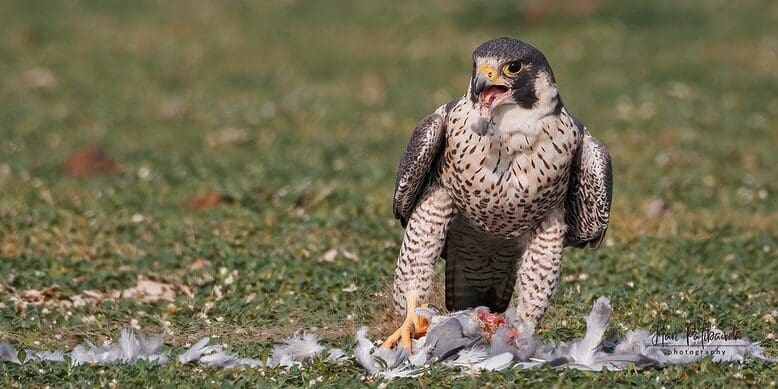A win for farmers, bees, and a threatened bird
This blog post was written by Dr Allan Perkins, Senior Conservation Scientist, RSPB Centre for Conservation Science.

Our new study, published in the Conservation Evidence Journal, shows that sowing a “green manure” seed mix in autumn can provide safe places for corn buntings to nest while improving soil condition on farms.
Once widespread across the UK, corn buntings Emberiza calandra have suffered huge declines, particularly in East Scotland where numbers plummeted by 83% between 1989 and 2007 [1]. This earned them the unfortunate accolade of being one of Scotland’s fastest declining species, and perhaps only 1,000 pairs remain across five regions. Work by farmers in Fife and Angus has dramatically improved the fortunes of this ground-nesting farmland bird. By growing wild bird seed mix, farmers have provided the three key things corn buntings need: seed for food in winter; insects to feed their chicks in spring; and, safe nesting sites.
However, in Aberdeenshire and Moray, reversing declines in numbers has been harder as the main challenge is safe nesting sites. In these regions, corn buntings tend to favour nesting in grass silage fields, which can act like a trap because their breeding season overlaps with when these fields are mown [2]. Corn buntings tend to start nesting in late May or early June, when the tall dense swards of silage fields often appear to be the best nesting habitat available, especially as cereals in this part of Scotland are mainly sown during spring and provide insufficient nesting cover until later in the summer. Unfortunately, most silage fields are then mown before the corn buntings have time to rear their young, as they require around four weeks from egg-laying until the chicks are capable of flight. Although they will often make a successful nesting attempt in cereal fields later in the summer, the species is adapted to rearing two broods per year, so nest losses to silage mowing in the early part of their breeding season is a significant problem.
Previous research by the Royal Society for the Protection of Birds (RSPB) in the 2000s showed that delayed mowing of silage fields until at least 1st August is effective at increasing nest survival rates sufficiently to halt local declines [2,3]. Agri-environment payments have been available for this since 2008, including in the current Agri-Environment-Climate Scheme (AECS). However, because the quality of forage harvested declines with later cutting, many farmers are unable to take up the delayed mowing option, so an alternative solution that works for more farmers is required.

This new study documents results from a management trial across six farms in Aberdeenshire between 2021 and 2023 that showed autumn-sown green manure crops as one such solution. Green manure crops are grown primarily to improve soil condition, with legume-based mixes commonly used because of their nitrogen-fixing properties which can reduce dependence on inorganic fertilisers. Plants widely used include clovers Trifolium spp., vetches Vicia spp. and phacelia Phacelia tanacetifolia. These crops can also alleviate soil erosion, compaction and water pollution, whilst biodiversity benefits include food and habitat provision for insects, birds and mammals. A spring-sown green manure option available in the Agri-Environment Climate Scheme has proved very popular with farmers in northeast Scotland in recent years.
Our trial tested whether sowing these crops in the autumn would provide a tall dense sward attractive to corn buntings by the following spring. The results showed that not only were corn buntings attracted to the trial plots in May and June, but they also continued to nest in the plots throughout summer, and with a high nest success rate (60%) that was similar to cereal fields later in the summer and much higher than in grass silage fields. Providing the crops are left undisturbed and in place until at least 15th August, autumn-sown green manure therefore has the potential to provide safe nesting sites for corn buntings and make a substantial contribution to saving one of Scotland’s most threatened farmland birds.
Our hope now is that Scottish Government will add autumn-sown green manure crops to the suite of corn bunting management options already available in agri-environment schemes, thereby providing another way for farmers to provide safe places for corn buntings to nest.
The full paper is free to read: Perkins A.J., McLelland A. & Stephan Y. (2025) Autumn-sown green manure crops for nesting corn buntings Emberiza calandra: management trials in North East Scotland (UK), 2021–2023. Conservation Evidence Journal, 22, 26–32. https://doi.org/10.52201/CEJ22/CKSW4581
References
[1] Watson A., Perkins A.J., Maggs H.E. & Wilson J.D. (2009) Decline of Corn Buntings Emberiza calandra on east Scottish study areas in 1989–2007. Bird Study, 56, 213–220. https://doi.org/10.1080/00063650902792072
[2] Perkins A.J., Maggs H.E., Wilson J.D. & Watson, A. (2013) Delayed mowing increases corn bunting Emberiza calandra nest success in an agri-environment scheme trial. Agriculture, Ecosystems & Environment, 181, 80–89. https://doi.org/10.1016/j.agee.2013.09.010.
[3] Perkins A.J., Maggs H.E., Watson, A. & Wilson J.D. (2011) Adaptive management and targeting of
agri-environment schemes does benefit biodiversity: a case study of the corn bunting Emberiza calandra. Journal of Applied Ecology, 48, 514–522. https://doi.org/10.1111/j.1365-2664.2011.01958.x.



